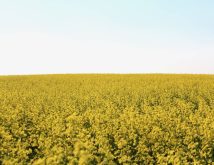Manitoba canola producers are hoping this season will echo last year’s scarcity of sclerotinia, but recent wet conditions may have laid groundwork for the fungus to return.
Dry weather last year tamped sclerotinia. The yearly disease survey found that, of 129 surveyed fields, only 13 per cent showed signs of the disease. Of those infected, severity (on a zero- to five-point scale) was measured at 0.2.
The year before, the fungus was present in 41 per cent of the 115 fields surveyed. In 2021, at the height of drought, only two per cent were infected.
Read Also

Manitoba boosts stake in cereals centre to $23.5 million
Premier Wab Kinew said the additional project funds will help ‘Trump-proof’ the provincial economy.
“Especially with the higher moisture, and then as we get into warmer temperatures, it’s providing that environment for disease potential … for sclerotinia and blackleg,” said Sonia Wilson, an oilseeds specialist with Manitoba Agriculture, during a June 12 Crop Talk webinar.
Why it matters: The ground is wet again, and that means potential sclerotinia issues. Timely fungicide application is crucial to stay ahead of the disease.
According to Manitoba Agriculture’s June 18 crop report, canola seeding was about 96 per cent complete. Crops were emerging in the southwest, and early-seeded canola showed good growth and development.
Seeding was 85-90 per cent complete in the northwest, with crops at varying stages due to challenging weather.
In central Manitoba, canola was at the rosette stage and some fields were bolting, although Manitoba Agriculture also noted hail and wind damage to various crops and property. About 98 per cent of canola in the east was seeded.
“Lots of the canola planted during the reporting period was broadcast and incorporated because of unfavourable soil moisture conditions,” the weekly report read.
“Crop stage ranged from emergence to rosette, and bolting not far off for the earliest seeded crop. Herbicide applications have begun but remain a challenge with unfavourable weather conditions for good herbicide performance. A limited amount of insecticide application has occurred to control flea beetles.”
Progress lagged in the Interlake. About 70 per cent of the region’s canola was seeded, while the oldest crops were at the three to four leaf stage. Moisture in the area has been a significant challenge. In the northern Interlake, only 50 to 65 per cent of fields were planted and some stands were poor.
Yield hit
“With the higher moisture that we’ve had, and with the coming warming temperatures and canopy closure, there is a higher risk for sclerotinia as well, which will very much affect your canola yield,” said Wilson.
Producers with crops damaged by hail could see delayed flowering and may have more time to apply fungicide. Timely application will be the most important tool, she added.
Foliar fungicides should be applied when about 20 per cent of the canola has bloomed. That can happen quickly when the temperature rises, Wilson noted, “especially since we’ve had such a cool cell, it’s going to happen real quick … so keep an eye out, know your crop staging and, especially with the moisture we’ve had, most likely sclerotinia spray would be worth it for the target yields that we are looking at if you don’t have really stressed crop at this point.”
Fungicide will also reduce dockage from sclerotinia contamination and poor seeds, she added.
The Canola Council of Canada also notes split application will protect canola longer if the bloom period is delayed due to inclement weather or branching from low plant populations.
Fight of the future
There is worry about resistance. One canola council research project is evaluating fungicide sensitivity of S. sclerotiorum samples taken from canola fields in Manitoba, Saskatchewan and Alberta to find out if the fungus that causes sclerotinia stem rot has become resistant to common fungicides.
Scientists are comparing samples to those taken in 2010 to identify any differences in sensitivity. Using the results, researchers hope to identify specific genetic markers linked to the genes responsible for fungicide resistance. That might eventually lead to varieties better able to withstand sclerotinia.
Last year, Mark Belmonte, a biology professor at the University of Manitoba, told the Manitoba Agronomists’ Conference that he and his team are using RNA interference in the fight. RNA transports genetic information to a cellular region where it undergoes conversion into a protein.
With RNAi (the “i” stands for interference), the protein-production process is manipulated. The technology promises to develop highly tailored control products that impact only the target organism. It could, for example, lead to development of a herbicide that hits a specific weed, leaving all other plants untouched.
















